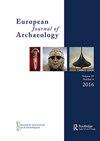“野兽出没的地方”:伊特鲁里亚人的狩猎和战利品展示,在波吉奥Civitate (Murlo),意大利
IF 1.4
2区 历史学
0 ARCHAEOLOGY
引用次数: 0
摘要
对公元前八世纪至六世纪居住的波乔文明伊特鲁里亚遗址(意大利穆尔洛)的动物考古、图像学和人工制品数据的综合研究揭示了遗址内动物身体部位和所代表物种(包括野生动物)分布和处置的差异。被困的小型哺乳动物和鸟类在现场车间区域更频繁地遇到,而被猎杀的大型猎物(鹿、狼、熊和龙)在精英住所区域更频繁。我们认为,这些遗骸中的一些是Poggio Citate精英狩猎的证据,我们讨论了这种活动在这个社区的社会影响。本文章由计算机程序翻译,如有差异,请以英文原文为准。
‘Where the Wild Things Are’: Etruscan Hunting and Trophy Display at Poggio Civitate (Murlo), Italy
An integrated study of the zooarchaeological, iconographic, and artefactual data from the Etruscan site of Poggio Civitate (Murlo, Italy), inhabited from the eighth to the sixth century bc, reveals intra-site differences in the distribution and disposal of animal body parts and species represented, including wild animals. Smaller mammals and birds that would be trapped are encountered more frequently in the site's workshop area and larger prey (deer, wolf, bear, and aurochs) that would be hunted are found more often in the area of the elite residence. We suggest that some of these remains are evidence that hunting was for the purpose of trophy display by the elites of Poggio Civitate and we discuss the social implications of such an activity in this community.
求助全文
通过发布文献求助,成功后即可免费获取论文全文。
去求助
来源期刊

European Journal of Archaeology
ARCHAEOLOGY-
CiteScore
3.40
自引率
6.70%
发文量
58
期刊介绍:
The publication organ of the European Association of Archaeologists, the European Journal of Archaeology seeks to promote open debate amongst archaeologists committed to a new idea of Europe in which there is more communication across national frontiers and more interest in interpretation. The journal accepts not only new empirical data and new interpretations of the past but also encourages debate about the role archaeology plays in society, how it should be organized in a changing Europe, and the ethics of archaeological practice. All periods are covered; papers, review articles, interviews and short "debate" pieces are all sought. Whilst English is the primary language of publication in the EJA, papers submitted in French or German will be given equal consideration.
 求助内容:
求助内容: 应助结果提醒方式:
应助结果提醒方式:


